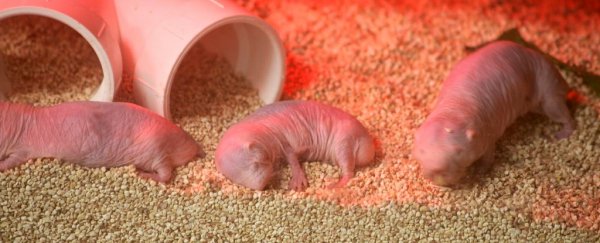For decades, scientists have been trying to understand the many superpowers of the naked mole rat - those pink, scrotum-looking creatures that can live upwards of 32 years, are resistant to cancer, and barely feel pain.
Now, researchers from Germany might have finally figured out how these strange rodents achieve at least one of these skills, by identifying the evolutionary changes that make them impervious to pain, but sensitive enough to avoid injury. And it could help us treat people dealing with chronic pain every day.
"We think evolution has selected for this tweak just subtly enough so that the pain signalling becomes non-functional, but not strong enough that it becomes a danger for the animal," said lead author Gary R. Lewin, from the Max-Delbruck Centre for Molecular Medicine in Berlin.
To be clear, naked mole rats aren't immune to pain, because that would actually be really dangerous, seeing as pain is what alerts us to injuries. Instead, they seem to be able to ignore certain types of inflammation that other animals - us included - find painful.
Consider a sunburn: as many of us know, sunburn really sucks when we take a shower or bath.
That burning sensation we get when hot water touches are sunburn is called thermal hyperalgesia, which is a just fancy way of saying that our bodies have an increased sensitivity to pain caused by damaged nociceptors - the sensory nerves that tell our bodies something is injured. This makes the water feel hotter than it really is.
A sunburned naked mole rat - go ahead and picture that - wouldn't have any of these issues, thanks to an evolutionary shift on a molecular level that keeps them feeling fine when other animals would be in agony from increased inflammation.
Our bodies respond to heat and inflammation by signalling to nerve growth factor (NGF) molecules to bind with a receptor known as TrkA. This opens up a channel called TRPV1, which then triggers the body to register pain in the affected areas.
To see how naked mole rats' systems work differently, the Berlin team compared their TrkA receptors to that of lab rats.
They found that if they combined a rat's TRPV1 channel with a naked mole rat's TrkA receptor, the channel remained closed when exposed to thermal hyperalgesia stimuli. This meant the animal wouldn't register any pain.
This suggests that a naked mole rat's TrkA receptor is different from those of other rodents, and could be the key to its higher resistance to pain.
The researchers performed further tests by comparing the gene responsible for the naked mole rat's TrkA receptor to those of 26 other mammals and five different African mole rat species. They found that naked mole rats had between one and three amino acids that were unique in their receptors.
In other words, the evolutionary mutation in naked mole rats' TrkA receptors appears to make them experience about one-third the pain that other rodents do.
"Even though the naked mole rat's version of the TrkA receptor is almost identical to that of a mouse or a rat, it has a very significant effect on the animal's ability to feel pain," Lewin said.
The team thinks this evolutionary change stems from the fact that naked mole rats live in cramped, underground colonies where heat would pose a problem to other mammals.
They also suspect that the reason naked mole rats even have these pain receptors at all is because they're needed in the embryonic stage to allow for all other pain channels to fully develop.
Another hypothesis offered up by the team is that these receptors might have grown weaker simply because naked mole rats don't need them, which means having them dulled down is a way to keep metabolic rates low.
"They live in desert regions underground, and they have to do a lot of work to get their food," said Lewin. "They have the lowest metabolic rate of any mammal. Evolution has shut down everything that is not absolutely necessary - including extra nerve receptors."
The next step for the team is to breed mice that have been altered to have naked mole rat TrkA receptors.
If they're able to understand how this uniquely dulled pain system works, it could open up new ways for researchers to develop pain management systems with humans in the future.
The team's work was published in Cell Reports.
